Allegations of computer hacking in Kenya's August 8 election have reignited a debate around the use of digital technology in national votes, with experts wondering whether sticking to paper may be best.
The discussion is no longer theoretical in Africa where an increasing number of countries are turning to electronic voting or including a digital component in the voting process, such as the biometric voter recognition kits and electronic results transmission system deployed in Kenya.
For example, the last two elections in Ghana, in 2012 and 2016, had a strong digital component while Namibia held the continent’s first ever completely digital election, or “e-vote” in 2014.
Zimbabwe is mulling the use of biometric voter recognition in 2018 while Botswana and Nigeria are considering conducting fully digital elections in 2019.
But the Kenyan experience could prompt a rethink.
In 2013, the computer system set up to verify voters and remit results to the national tally centre in Nairobi failed, forcing the election commission (the Independent Electoral and Boundaries Commission, IEBC) to revert to a manual count. The opposition claimed sabotage in the collapse of the digital system.
Four years later, the tablets used for the voter identification and results transmission worked well, but the opposition claimed computer servers were hacked and an algorithm inserted to artificially inflate the number of votes for incumbent President Uhuru Kenyatta while deducting them from his challenger, Raila Odinga.
The Supreme Court on September 1 invalidated the presidential election and Kenyatta’s victory, singling out “irregularities and illegalities in the transmission of results”.
– Questions over transparency –
The judges’ full ruling, due by September 22, is expected to reveal whether electronic failures, or fiddling, were detected.
As Steve Kremer, a researcher at Inria (France’s National Institute for Computer Science and Applied Mathematics), pointed out, one pillar of electoral democracy — alongside secrecy of the ballot and integrity of the result — is transparency of the process, meaning the ability of voters “to understand the underlying system”.
“Germany prohibits electronic voting on the grounds that it lacks transparency and so is unconstitutional,” he said.

Remind me, what’s an algorithm?
That also appeared to be the problem in Kenya where Supreme Court judges, newspaper editors, lawyers and voters found themselves confronted with arcane terminology — “servers”, “logs”, “algorithms” — and technicalities that are harder to make sense of than traditional, manual methods of rigging an election such as stuffing ballot boxes or falsifying votes.
Election observation missions, tasked with monitoring the vote, also struggled with their lack of expertise when it came to allegations of computer hacking.
“I think it is a crucial point and we should all think about how observers can deal with this, because there is now a black box that very few people can look into,” said Marietje Schaake, the European Union’s chief observer for the Kenya vote.
She also raised concerns over the key role of “private companies” that provide services or equipment but “may be more concerned about their reputation than about serving the public interest.”
Most observers found biometric voter recognition worked well on election day, a view shared by Kenyan voters AFP spoke to at the time.
– Hacking and verification –
But the transmission of results is more difficult to observe and aroused suspicions among the opposition which claimed French company OT Morpho had “participated in rigging the election,” an allegation the company rejected.
“The system has not been hacked and there was no attempt at intrusion,” it said.
As a result Kenyan voters were trapped between opposing experts claiming fraud and hacking on the one hand, and blanket denials on the other.
The task of authenticating every paper tally sheet from all 40,883 polling stations, in order to determine the legitimacy of the outcome of the vote, irrespective of any breakdown in the electronic system, fell to the IEBC.
It claimed to have done this, but the opposition challenged the assertion arguing many of the paper tally sheets are in fact forgeries, lacking the right signatures and security water marks.
For Veronique Cortier, director of research for the CNRS (the National Centre for Scientific Research) at Loria (the Lorraine Research Laboratory in Computer Science and its Applications), e-voting is certainly not dead despite the problems, and solutions offering more security and transparency are being developed.
But as things stand, she said, the old ways are the best. “Even if the paper ballot is not perfect — even if there is fraud — you can be more certain of a more legitimate process, and there is more transparency, than with the digital systems.”






